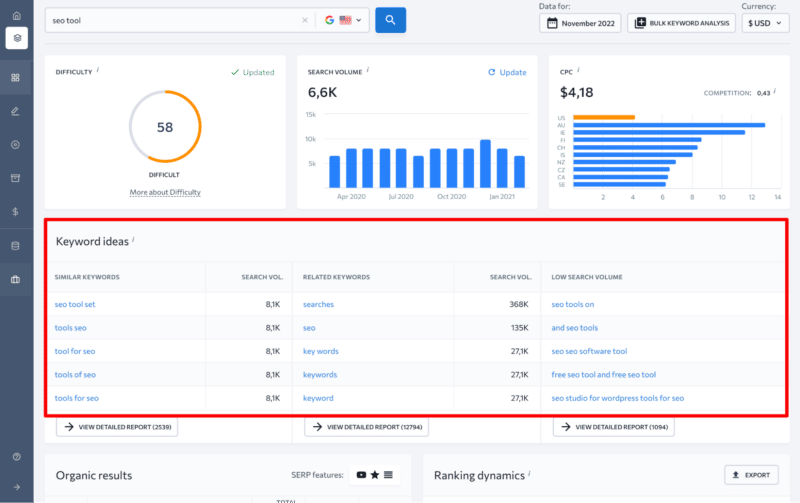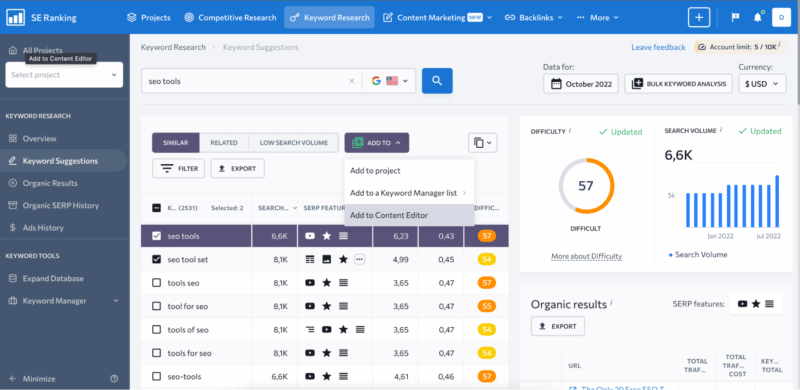
3 simple steps to automating content creation for businesses by SE Ranking

All parties involved in the content creation process know just how much time, effort and financial resources go into it. Writing a piece of content with a chance of ranking at the top of the search results takes up a good chunk of those resources. As companies grow and develop, the resources available for projects (especially time) can diminish.
In this article, we will discuss how to leverage content research and automation tools to cut corners and preserve valuable resources. Take advantage of these tips and tricks to create quality content that both Google and people will love.
What is content automation, and why do you need it?
Content marketing automation involves identifying repetitive content marketing tasks and then using relevant tools to automate those tasks.
Think about it. If your content automation software is doing all the heavy lifting, SEOs will no longer have to waste hours of their time each week writing out detailed content briefs for content creators. Instead, your copywriters can skip the SEO learning curve and focus on crafting compelling sentences to create even more compelling content.
With automation software, your SEO and content teams can save time, cut costs, make smarter decisions, and focus on crafting marketing strategies that really make a difference.
From doing research to creating content and optimizing it, content automation tools can improve your productivity across the entire content life cycle.
Creating content is a process that includes some indispensable steps, namely:
- Determining the article topic
- Creating a content brief
- Writing an optimized article copy
Performing these tasks manually would take up a lot of the SEO and content teams’ time. Luckily, content research and automation tools help you cover and fast-track your entire content creation journey—all in one place.
There is a range of content tools on the market, but for the purpose of this article, we’ll illustrate how to automate your content creation by using SE Ranking’s content tool, the Content Marketing Platform. It helps you craft content briefs in just a few minutes and write full-fledged articles in as little as a few hours.
To elaborate, SE Ranking’s Content Marketing Platform relies on AI when analyzing your competitors’ content. It pulls data from top-ranking pages to let you know what to aim for in your content in order to outrank them.
This tool also uses NLP to suggest the most suitable keywords to use in your content. It points out the terms that both Google and people expect to find on a page relative to the topic.
Let’s move on to dissecting the content creation process.
Step 1. Determine the article topic
Many SEO and content marketing specialists bank a good chunk of their content creation efforts on keyword research. After all, doing keyword research is the first step towards searching for an article topic. It’s how to find out what people are talking about the most. You’re discovering which topics are currently in higher demand.
By optimizing content pieces for search, SEOs and content marketers generate a steady flow of traffic to their websites. They cover various search intents to help users move down the search funnel.
To make sure you’re automating the entire process, check to see if your keyword research tool can:
- Suggest similar, related and long-tail keywords with various search volumes based on a seed keyword.
- Provide you with complete and accurate data on keyword metrics, including search volume and keyword difficulty.
- Highlight SERP features for every keyword.
- Indicate a keyword’s user intent.
- Show you how volatile a keyword SERP is and how authoritative its players are.
Pay close attention to how large your keyword research tool’s database is and how much you can rely on it in terms of accuracy.
SE Ranking’s Keyword Research tool ticks every box in this respect. Plus, it’s a part of a larger ecosystem of tools, meaning you can seamlessly manage all of your site’s data from one central hub.

With this tool, you don’t have to export anything to Excel. No more working with data in a dull environment.
Instead, you can directly add the keywords you’re interested in targeting to one of SE Ranking’s tools. These include Keyword Manager, Keyword Rank Tracker and Content Editor (this tool is where all the content creation magic happens).

After finishing your research and choosing the main keyword (or several related keywords) that you want to focus your new piece of content on, settle on the article’s main topic. Then, start creating an SEO content brief for your copywriter.
Step 2. Create a content brief
Since your copywriter relies on you to be the SEO expert, specify in the content brief what you want the article to look like.
Start by analyzing the top-ranking SERP players in your selected region to understand what works for them. Use that information to write out a detailed brief. Filter out the competition, so it only includes websites similar to yours in terms of user intent.
To do this, visit each competitor’s website to make sure they are properly communicating the topic at hand to their audience. Their content should be tailored not just to the right audience, but to the stage they’re at on the buying journey.
Once you’ve selected the right digital rivals, go over your upcoming article’s content parameters. Note that the default values in SE Ranking’s Content Marketing Platform are displayed as an average of every selected competitor, but you are free to change them as you see fit. Consider deciding on your own how many words or characters should be included in the text, how many headings and paragraphs the text should be broken down into, as well as how many images will make the text easier to read.

Every SEO pro knows that you should include specific keywords in your text to increase its chances of appearing in Google for a related search. This is where you can get additional help and get a list of NLP keywords that Google considers essential.
Last but not least, analyze competitor page heading structures to create a detailed outline of your upcoming article. You can either copy competitor headings as is or draw inspiration from them and create your own structure with unique headings.
Your copywriters will then have a detailed article outline specifying everything from its length to the number of times a keyword should be used on the page.
Step 3. Write an optimized article copy
As a content creator, use the detailed SEO content brief as a basis for writing the article copy.
You can take the traditional route and write the text right on the spot, or you can turn to an AI rewriter for help if you feel stuck.
Practically every modern content marketing automation tool gives you the opportunity to take a piece of text from a competitor’s website and insert it into your own copy. It then offers plagiarism-free alternatives for you to use in your article.
If you’re in a hurry, you can take this method to its extreme by pulling relevant chunks of texts from competitor articles and letting the AI rewrite plagiarism-free alternatives. But, of course, it’s always better to let the experts do their thing.
Once you, as a copywriter, are happy with the text of your soon-to-be-published article, optimize it to increase its chances of outranking the top competition.

Since all of the requirements are right there next to your text, along with gauges, you can see exactly how well the text is optimized.
Make sure the copy has enough total words and that specific keywords aren’t used too much. Get rid of any punctuation and grammar mistakes, and make sure the readability level is appropriate.
All data is clearly laid out in the Content Marketing Platform so that content creators don’t have to jump through any additional hoops to create SEO-friendly texts.
Until the end of the year, you can get a 30% discount on your first purchase of the Content Marketing Platform by using the promo code Content30 at checkout.
Bonus: Keeping track of your pages’ Google rankings
After publishing your brand new piece of content, keep track of its performance in search. This is to gauge the ROI of all the time and effort you put into creating it.

SE Ranking’s Keyword Rank Tracker delivers extensive ranking data with pinpoint accuracy across every major search engine. Add your website, specify the search engines and competitors, and keep daily track of your target keywords’ ranking positions.
This is so you can act quickly if your rankings change or if another competitor pulls out all the stops to outrank your pages.
Recap
The best way to leverage content marketing automation tools is to use them to help humans—not to replace them. Let your content automation tool do most of the heavy lifting so you can automate repetitive manual processes. Free yourself up to do higher-value creative tasks.
When content marketing automation tools are used correctly, they can skyrocket your digital business’s efficiency, save you a small fortune each month, improve your customer service and improve the overall quality of your products and services.
Do less and get more done!
The post 3 simple steps to automating content creation for businesses appeared first on Search Engine Land.
from Search Engine Land https://searchengineland.com/3-simple-steps-to-automating-content-creation-for-businesses-389373
via FREE SEO TOOLS